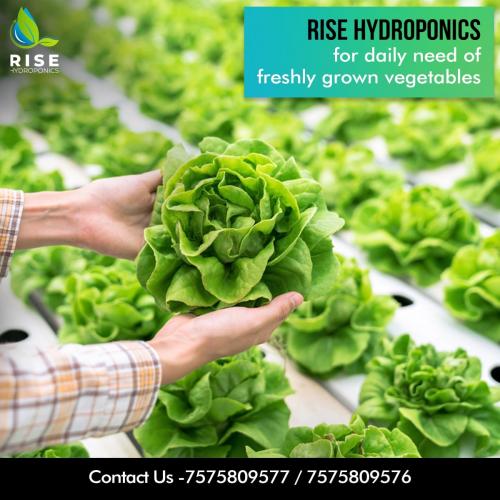Types of Hydroponic Farming

The farming system of Hydroponics, soil-less cultivation of crops has revolutionized the agriculture sector by offering products of better quality and productivity. This technique is applied in the cultivation of a large variety of crops involving vegetables, ornamentals, medicinal crops, herbs and spices. Hydroponics plays a vital role in the year-round supply of seasonal vegetables; it also enables the cultivation of exotic vegetables.
Types of Hydroponic farming
· Outdoor hydroponic systems
Here hydroponic setup is installed in open fields or terraces where the crops are cultivated in the natural environment .
Here, the hydroponic system is installed in closed structures such as greenhouses and crops are grown under controlled environment within the structures. In this type, the required radiation is provided with the help of artificial light.
· Passive System
This system uses a growing medium for retaining moisture and to supply nutrients
· Active system
This system brings the water and nutrients to the crop plants with the help of pumps and pipes
· Wick system
It makes use of the passive system where the crops are anchored by growing mediums such as vermiculite, coconut fibre, perlite etc. The nutrient solution from the reservoir is absorbed by the plants through a wick. The wick system eliminates the use of aerators, pumps, or electricity. It can be said that it is the only hydroponic system that doesn’t require the use of electricity. This system is best for small garden plants and herbs. Plants requiring comparatively less water requirement are grown using this system.
· Deep water culture system
This system remains the simplest of all hydroponic systems, here the crop roots are completely immersed in the water. Oxygen and nutrients are provided to the plant roots with the help of air pump. The best part of this system is that the plant roots are directly in touch with the nutrient medium making easy absorption of nutrients by the plants resulting in quick growth. The system is suitable for any kind of plant irrespective of their size.
Recirculating Deep Water System
Recirculating a deep water system covers the shortcomings of the traditional or normal system. This system doesn’t drain out the nutrient solution, meaning , the solution keeps on circulating throughout the structure.
· Nutrient film technique system
The nutrient solution is recirculated in this system, minimizing the wastage of resources. Here, the plants absorb oxygen and nutrients from the flowing solution. Oxygen and nutrients are pumped into the growing tray from the reservoir with the help of a pump and the excess solution is drained back to the reservoir. The system is usually used in the cultivation of lettuce and it gives best results for light-weight, fast growing crops.
a) Flat Bed NFT System
In this type of NFT, the channel is placed parallel to each other with the same elevation from the ground.
b) A Frame System
In this type, the channels are arranged in a structure resembling ‘A’ where plants are placed in channels one upon the other. This system accommodates more plants than flat bed types in the same space.
· Ebb and Flow (Flood and Drain)
The Ebb and Flow system is mostly used for home gardens. Here, the plants are kept in large grow beds made of growth medium like rockwool or perlite. After planting, the grow bed is flooded with nutrient-rich solution.
The water pump is fitted with a timer which ensures switching on and off of the pump at regular intervals. After flooding the bed with nutrient solution, the water is drained out from the bed reverting it back into the pump. This system is applicable to almost all types of crops including root crops.
· Drip Systems
Drip systems are highly effective and easy-to-use hydroponic systems that are capable of making alterations suiting different types of plants. Here, the nutrient media is circulated to a drip system and is pumped into a tube which directs the solution to the plant base. A drip emitter placed at the end of each tube controls the amount of solution supplied to the plant. The flow of the solution can be adjusted according to individual plant requirements.
Drip systems can be of circulating or re-circulating type. Circulating systems drip almost constantly and extra solution will be sent back into the reservoir. Due to the possibility of alteration, these systems are used to grow any plant.
· Dutch Bucket System
In Dutch Bucket system, plants are lined in a row placed in buckets with 1-2plants in one bucket. Drip hoses connected to the water line which runs throughout the length of the system from the water pump are placed at each plant using drip emitters, creating a constant drip.
The system is especially useful for the cultivation of vine plants as well as large plants.
· Vertical Hydroponics System
Here, the plants are grown in stacks or towers. A single tower can easily hold dozens of plants, stacked one on top of the other, and all being fed nutrients through the same system. In this method farms take up 99% less land, making them easier to fit in greenhouses.
The technology of hydroponics offers a bright future for agriculture which at present, is facing various challenges including pest resurgence, pesticide resistance, poor soil fertility, desertification, unavailability of water for irrigation and degraded arable land. The most notable problem faced by the farming community is the ever changing and unpredictable weather. Taking all these concerns into account, the all in one solution is the adoption of hydroponics since the crops here are grown in controlled, soil- less environment eliminating the chances of climatic challenges, pest attack (soil-borne) and unavailability of land. The technology could also reduce the incidences of soil and water pollution to a large extent. This system is proven to be highly efficient in saving water, thus giving new dimensions to farming, revolutionizing the conventional ideology of agriculture.
Post Your Ad Here
Comments